Possibly the Lowly Mosquito
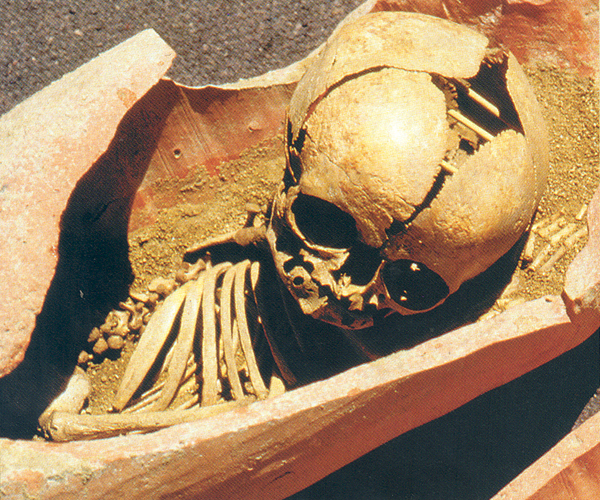
Everybody blames the barbarians for the fall of Rome. Some point the finger at the 410 A.D. attack by the Germanic Goths. Others say the final end came later, around the time of the 476 A.D. deposition of Augustulus, the last emperor of the western Roman empire, by the barbarian Odoacer.
A recent study, however, identifies another culprit, Plasmodium falciparum, a virulent strain of malaria that hit the area around Rome in 450 A.D. According to David Soren of the University of Arizona, the malaria epidemic would have severely weakened the empire, making it susceptible to barbarian invasions.
From 1988 to 1992, Soren’s team excavated a mid-fifth century A.D. cemetery 70 miles north of Rome. They uncovered more than 50 skeletons (including the one shown at left) of stillborn infants, newborn infants and small children, all buried within a brief time span. Some of the older children had pitted skulls, a sign of infectious disease.
Researchers at the University of Manchester Institute of Science and Technology, in England, analyzed DNA samples from the leg bones of a 3-year-old child to try to determine the cause of death. The DNA matched that of people infected with Plasmodium falciparum, a disease to which infants and small children are particularly susceptible. This strain of malaria also causes miscarriages in pregnant women, explaining the large number of stillborn skeletons found at the site.
The epidemic was so bad that Christian Romans apparently resorted to pagan rituals. Soren told Archaeology Odyssey that his team found skeletons of decapitated puppies, a raven’s talon, a toad’s skeleton and offerings of honeysuckle among the remains of the dead—all talismans thought to ward off evil. One child’s “hands and feet were weighed down with stones so he could not rise from the dead,” Soren said.
The plague may have been somewhat of a mixed blessing. When the epidemic struck, Attila the Hun was wreaking havoc throughout Italy. Although Christian texts say that the intervention of Pope Leo I stopped him from sacking Rome, this new evidence of a malaria epidemic suggests his armies were scared off by fear of infection.
Will Ozymandias Command and Sneer Again?
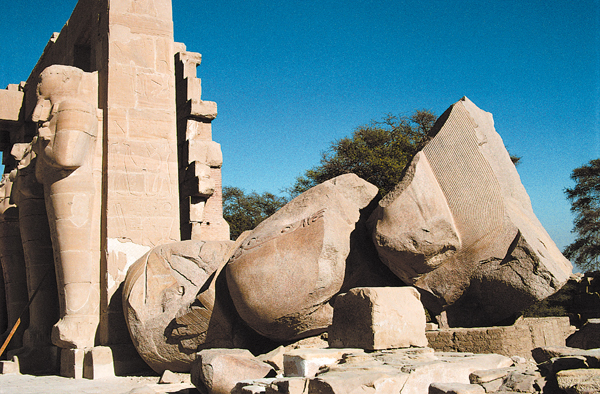
Immortalized as the vainglorious Ozymandias in Percy Bysshe Shelley’s eponymous sonnet, a colossal statue of the Egyptian pharaoh Ramesses II (1279–1213 B.C.) will be reconstructed, Egyptian officials say.
The announcement followed a meeting held last winter between Egyptian president Hosni Mubarak and French archaeologist Christian Leblanc, who has worked for 12 years at the Ramesseum, Ramesses II’s funerary temple in Thebes, where the statue’s “shattered visage” lies.
The pink granite remains of the “colossal wreck” are now strewn at the entrance to the Ramesseum’s second court. Although the statue’s head, shoulders and base can be reassembled, its legs no longer remain. The 55-foot-high statue (its ears are more than 3 feet long) of Ramesses—often thought to be the Pharaoh of Exodus—once weighed over 1,000 tons and is one of the largest freestanding sculptures ever made.
Ozymandias
I met a traveller from an antique land
Who said: Two vast and trunkless legs of stone
Stand in the desert. Near them, on the sand,
Half sunk, a shattered visage lies, whose frown,
And wrinkled lip, and sneer of cold command,
Tell that its sculptor well those passions read
Which yet survive, stamped on these lifeless things,
The hand that mocked them and the heart that fed;
And on the pedestal these words appear:
“My name is Ozymandias, king of kings:
Look on my works, ye Mighty, and despair!”
Nothing beside remains. Round the decay
Of that colossal wreck, boundless and bare
The lone and level sands stretch far away.
1) When was the Bronze Age?
a) fourth millennium B.C.
b) third and second millennia B.C.
c) first millennium B.C.
d) first millennium A.D
2) Which era preceded the Bronze Age?
a) the Iron Age
b) the Neolithic Period
c) the Byzantine Period
d) the Chalcolithic Period
3) Bronze is an alloy of which two metals?
a) tin and magnesium
b) silver and iron
c) copper and tin
d) gold and silver (same as electrum)
4) What caused the sudden collapse of the Bronze Age?
a) prolonged drought
b) invasions
c) earthquakes
d) all of the above
5) The Sea Peoples, as described in inscriptions of Pharaoh Ramesses III, were
a) fierce, invading tribes arriving en masse from the Aegean Sea
b) a desert people, called the Garamantes by the Greeks, who roamed the Sahara
c) Phoenicians inhabiting the Barbary coast
d) Israelites who vanished into the Red Sea
6) The devastation at the end of the Late Bronze Age was followed by
a) a Dark Age
b) a resurgence of interest in mathematics, during which the number 0 (zero) was invented
c) the rise of Egypt’s New Kingdom
d) the Mycenaean invasion of Crete
7) Which of the following was not a Bronze Age people?
a) Hittites
b) Minoans
c) Hurrians
d) Sasanians
8) The photo below shows
a) the Black Obelisk of Shalmaneser III
b) the Moabite Stone (or Mesha Stela)
c) a Hurrian-Hittite bilingual tablet from Hattusa
d) a stela with Hammurabi’s law code
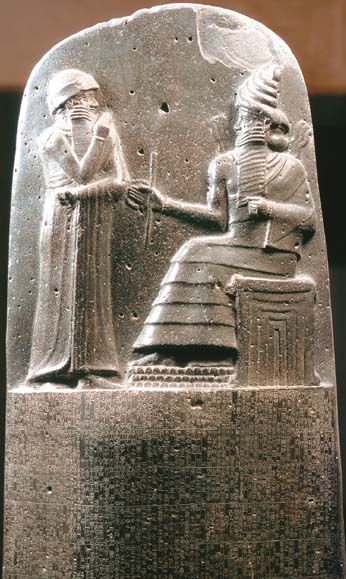
Answers
1) b, 2) d, 3) c, 4) d, 5) a, 7) d, 8) d
No, Just Another Case of Disarticulated Bones
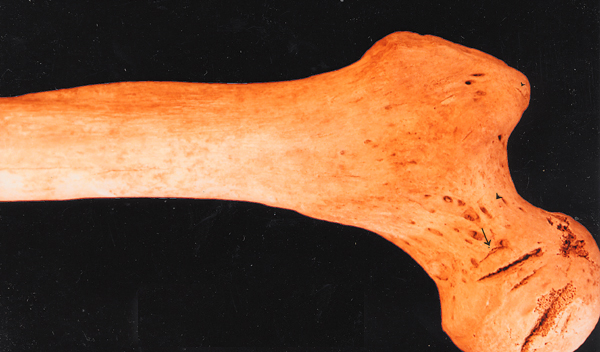
While sojourning east of the Ural Mountains, the Greek historian Herodotus (484–425 B.C.) encountered a people called the Issedones who, he said, practiced a form of cannibalism:
“When a man’s father dies, all his relatives bring livestock to his house. They sacrifice the animals and chop the meat up into pieces—and then they also chop up their host’s dead father, mix all the meats together, and serve them up as a special meal” (Histories 4:26).
According to a new study, however, Herodotus probably gave these ancient tribesmen a bum rap. Eileen Murphy, a researcher with Queen’s University in Belfast, has studied about a thousand first-millennium B.C. burials in Aymyrlyg, in southern Siberia, which was home to semi-nomadic steppe populations similar to those described by Herodotus. She has determined that numerous skeletons excavated from communal log-house tombs were indeed deliberately disarticulated, but definitely not butchered.
What’s the difference? Nomadic peoples have a special problem in burying their dead: They often find themselves far from their homes and sacred burial grounds. Murphy believes that when the Aymyrlyg tribesmen seasonally migrated in search of summer pastures for their flocks, they dismembered (and perhaps defleshed, for reasons of sanitation) their deceased in order to transport the corpses back home. Herodotus may well have thought he was seeing cannibalism when, in fact, he was witnessing the greatest possible respect a migratory people could show the dead.
Think Again
On the plain of Marathon, in eastern Greece, the Athenian army stopped the powerful Achaemenid king Darius the Great from expanding the Persian Empire into Europe. The Greek general Callimachus cunningly won the 490 B.C. battle by outflanking the Persian army and cutting them off from their ships. Our modern 26.2-mile foot race, or marathon, celebrates the herald who ran from the Marathon battlefield to Athens to announce the victory—and then dropped dead of exhaustion.
Of course, the 2004 Summer Olympics, to be held in Athens, will feature a marathon. But its venue will not be Marathon. Instead, the Athenian Olympic organizing committee is building an artificial lake at the site to hold Olympic nautical events.
Archaeologists and environmentalists oppose the plan, saying it will damage both the historic integrity of the site (which contains a grave mound where the fallen were buried 2,500 years ago) and wetlands that are home to rare bird species.
The organizing committee insists that its plan will not alter the historical site. According to the culture ministry, the proposed site for the nautical center was under water in 490 B.C. The ministry also announced that the archaeological treasures in the area, including the funerary mound and an Egyptian temple, will undergo conservation as part of the plan.
Greek plans for the Olympics have been plagued with problems from the beginning. Last year, the International Olympics Committee threatened to find a different host for the event if Athens failed to meet its deadlines. Clashes between Olympics personnel and archaeologists have been partly to blame for the delays, since Greek law requires construction to stop whenever remains are found—and, given Greece’s rich cultural history, remains are found almost everywhere.
Eternal Egypt: Masterworks of Egyptian Art from the British Museum
Memphis, TN
(901) 312–9161
Through October 21, 2001
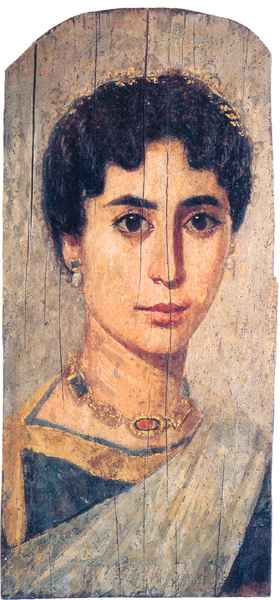
Scores of objects from the British Museum’s collection of Egyptian antiquities, dating from the early third millennium B.C. to the early first millennium A.D., are on display in a gallery designed like a pyramid.
Syria: Land of Civilizations
Wilmington, DE
(302) 425–3929 or (888) 862-ARTS
Through October 21, 2001

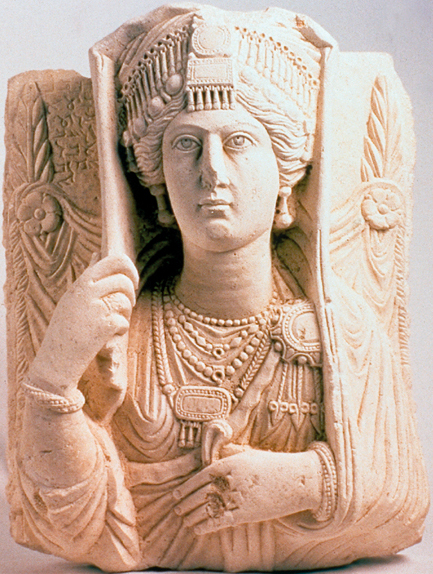
A dozen museums in Syria lent objects for this exhibition of Syrian art and history, including a million-year-old flint ax fashioned by a member of Homo Erectus. The exhibit is curated by Richard Zettler of the University of Pennsylvania Museum of Archaeology and Anthropology.
Cleopatra
Chicago, IL
(312) 665–7100
www.fieldmuseum.org
October 20, 2001, through March 3, 2002

Examining all aspects of the life of the enigmatic Egyptian queen (portrayed above by Vivian Leigh), this exhibit includes hundreds of sculptures, mosaics and frescoes from museums around the world.
Recent Acquisition: Head of A God
(713) 639–7540
Permanent Collection

A second-century B.C. Hellenistic bronze head is now part of the permanent collection of the Houston Museum.
Hieroglyphics at CVS


The familiar pharmacist’s “Rx” (for prescription) derives from an ancient Egyptian symbol worn as an amulet to ward off illness. The so-called Eye of Horus was depicted as a human eye and eyebrow embellished with markings of a falcon’s eyes. Ancient Egyptian myths recount a battle between the falcon-headed god Horus and his evil uncle Seth, who murdered Osiris, the father of Horus. During the fight, Seth plucks out his nephew’s eye. Thoth, the god of wisdom and magic, pieces the eye back together and returns it to Horus—who promptly gives it to Osiris, bringing him back to life.

